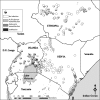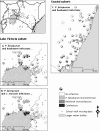Plasmodium-helminth coinfection and its sources of heterogeneity across East Africa
- PMID: 22262792
- PMCID: PMC3274378
- DOI: 10.1093/infdis/jir844
Plasmodium-helminth coinfection and its sources of heterogeneity across East Africa
Abstract
Background: Plasmodium-helminth coinfection can have a number of consequences for infected hosts, yet our knowledge of the epidemiology of coinfection across multiple settings is limited. This study investigates the distribution and heterogeneity of coinfection with Plasmodium falciparum and 3 major helminth species across East Africa.
Methods: Cross-sectional parasite surveys were conducted among 28 050 children in 299 schools across a range of environmental settings in Kenya, Uganda, and Ethiopia. Data on individual, household, and environmental risk factors were collected and a spatially explicit Bayesian modeling framework was used to investigate heterogeneities of species infection and coinfection and their risk factors as well as school- and individual-level associations between species.
Results: Broad-scale geographical patterns of Plasmodium-helminth coinfection are strongly influenced by the least common infection and by species-specific environmental factors. At the individual level, there is an enduring positive association between P. falciparum and hookworm but no association between P. falciparum and Schistosoma species. However, the relative importance of such within-individual associations is less than the role of spatial factors in influencing coinfection risks.
Conclusions: Patterns of coinfection seem to be influenced more by the distribution of the least common species and its environmental risk factors, rather than any enduring within-individual associations.
Figures





